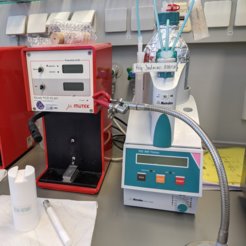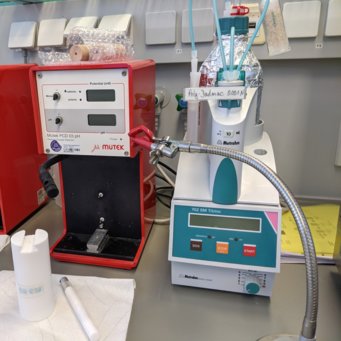
Particle Charge Detector

PCD is a technique based on the electric double layer that forms in a solution containing electric charges such as charged nanoparticles. The instrument generates movement in the sample which allows the mobile counterion layer (that surrounds the particle) to move. The instrument measures the current (mV) of these counterions. At this point we start a titration: a polyelectrolyte (PE), with opposite charge in respect to the sample, is added to the solution. The PE interacts with the sample reducing its surface charge. By doing so the counterion layer will also decrease thus changing the measured current. Once the current = 0 we stop the titration and we can back calculate the amount of charges on the particle.
Typical measurements:
Colloids or macromolecules, MW > 300 g/mol, diameter between 1 nm and 150 µm.
Equipment:
The equipment is composed by the “Mütek PCD 02” (which does the measurement) and the “702 SM Titrino” for the titration.
References:
[1] Short introduction of BTG for mütekTM PCD.
[2] Müller, R. H.; Mehnert, W.; Paulke, B.-R., Zetapotential und Partikelladung in der Laborpraxis. Wissenschaftliche Verlagsgesellschaft mbH Stuttgart, 1996.
Contact:
Francesca Mazzotta ( 06131-379-192)
Dr. Lucas Caire da Silva ( 06131-379-581)
